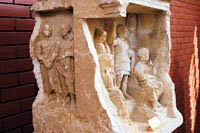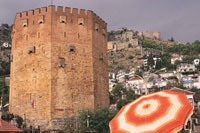Where to Visit
Archeology Museum
 The museum includes certain sections in which archeological and ethnographic works are kept and exhibited. The most ancient work displayed in this museum, is the inscription in Phoenician language dated back to 625B.C. Bronze, marble, ceramics, glass and mosaic finds belonging to Roman, Byzantine periods, an epitaph in Karaman language and coins of Archaic (7-5 B.C century) , Classical Ages, Roman, Byzantine, Seljuk, Ottoman and Republican Periods are exhibited in archeology section. The ethnography section includes Turkish Islamic works of art and traditional belongings, guns, handicrafts, jewels, pots and pans collected from the environs of Alanya. A symbolic section of a traditional Alanya house can also be seen in this part.
The museum includes certain sections in which archeological and ethnographic works are kept and exhibited. The most ancient work displayed in this museum, is the inscription in Phoenician language dated back to 625B.C. Bronze, marble, ceramics, glass and mosaic finds belonging to Roman, Byzantine periods, an epitaph in Karaman language and coins of Archaic (7-5 B.C century) , Classical Ages, Roman, Byzantine, Seljuk, Ottoman and Republican Periods are exhibited in archeology section. The ethnography section includes Turkish Islamic works of art and traditional belongings, guns, handicrafts, jewels, pots and pans collected from the environs of Alanya. A symbolic section of a traditional Alanya house can also be seen in this part.
Kızılkule Ethnography Museum

Being the symbol of Alanya, this monumental building was constructed in 1226 for military purposes to defend the pier and was one of the unique sample of Seljuk art. After being restored between 1951-1953, the structure gained the function of ethnography museum through the exhibitions of carpets, clothing, pots and pans, guns,etc peculiar to Alanya.
Alanya Castle
Alanya Castle is the only Seljuk’s castle which has been preserved until the present day. In 1225 Selçuk Sultan Alaaddin Keykubat built the castle on top of the Roman ruins. The castle is a treasure chest of history. Inside the castle ramparts there are Agios Georgios Church, Kanuni Sultan Süleyman Mosque, Akşebe Sultan Tomb, the Seljuk Baths, the artisans' shops, the bazaar's storage rooms, the tomb of Zitti Zeynep, the Palace of Sultan Alaaddin, big and small cisterns, a lighthouse and a dungeon.
The Red Tower
The Red Tower (Kızıl Kule) was built in 1226. The five-storey tower is octagonal. The main support structure of the tower also serves as a cistern. The bottom floor of the tower is now an ethnographic museum.
Leartis-Learti (Mahmutlar Ruins)
This city is 22 km from Alanya, has churches, baths, cisterns, residential buildings, a small stadium and theater, temples and streets lines with columns.
Syedra Ruins
The city of Syedra was founded in the 3rd century BC on the top of a hill, between the modern day villages of Kargacı and Seki. Inscriptions found in the portion of the city which was located on the hill and the surrounding area prove that it is an old Roman ruin. The lintels of the monumental city gate are still standing. There are 3 pools in the city which were most likely used as water depots and on both sides of the column-lined streets there are historic structures and mosaics.
The Port City of Iotape (Aytap)
Iotape is 30 km east of Alanya. The modern day highway along the Mediterranean coast goes right through this Roman city. The city was named in memory of King Antiochus' wife, Iotape. The city has a small port measuring 50-100 meters. The most well preserved parts of the city of Iotape are the remains of the old street, the baths, a church, a necropolis and acropolis.
Selçuklu Shipyard
Built in 1228, the shipyard is 56,5 m in length, 44 m in depth and includes 5 rooms. In case of any danger might come from the south, the shipyard has been strengthened by a two storey and two room tower.
Süleymaniye (Kale) Mosque
The mosque, which reflects Ottoman architectural design, is known to have been built in the 16th century on the top of a Selçuk temple. The wooden windows and doors are beautiful examples of Ottoman carvings.
Emir Bedrüddin Mosque
Beside this mosque, which Emir Bedrüddin built in 1227, is a small minaret made of cut stone. Its pulpit is one of the examples of carving art.
Akşebe Sultan Mosque
Akşebe Sultan is one of the first commanders of Alanya castle.The mosque was made to be built by him in 1230. On the western side of the mosque there is a minaret special to its own architectural style.
Alara Inn
Built in 1232 by Sultan Alaaddin Keykubat, the Alara Inn is located on Alara Creek which forms the boundary between Alanya and Manavgat, 9 km in north of the sea. The 2000 m² inn is made entirely of cut stone. The guardhouse, fountain, mosque and baths are in mint condition and certainly worth seeing.
Şarapsa Caravanserai
Located on the 15th km of the Antalya- Alanya highway, Şarapsa Caravanserai was constructed by Sultan Alaaddin Keykubat's son Giyaseddin Keyhüsrev II in between the years 1236-1246 on an area which is approximately 850m².
Caves
Damlataş Cave
Büyük Dipsiz Cave
Çimeniçi Cave
Dim Cave
Beldibi Cave
Derya Cave
The Others Important Caves
Kadıini Cave
Situated about 15 km in northeast of Alanya, at a place called Çatak, the picnic areas in the vicinity bring a liveliness to the area.
Korsanlar Cave
The mouth of the cave, which is approximately 10 m wide and 5-6 m. tall, is big enough to allow boats to go in and out. The dome-shaped interior with its colorful ceiling leads northward into the pitch-black depths of the cavern.
Lovers Cave
The mouth of the cave is about 2 m. above the sea and big enough for a person to get through. The mouth of the cave is adorned with stalactites, stalagmites and columns.
Fosforlu Cave
Having a similar appearance with Korsanlar Cave, Fosforlu Cave can be accessible by boat since its entrance is wide enough. Various hues deep into the sea display superb spectacle.